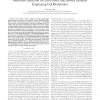Free Online Productivity Tools
i2Speak
i2Symbol
i2OCR
iTex2Img
iWeb2Print
iWeb2Shot
i2Type
iPdf2Split
iPdf2Merge
i2Bopomofo
i2Arabic
i2Style
i2Image
i2PDF
iLatex2Rtf
Sci2ools
104
click to vote
VTC
2010
IEEE
2010
IEEE
Receiver Multiuser Diversity Aided Multi-Stage MMSE Multiuser Detection for DS-CDMA and SDMA Systems Employing I-Q Modulation
Abstract— The so-called receiver multiuser diversity aided multistage minimum mean-square error multiuser detector (RMD/MS-MMSE MUD), which was proposed previously by the author, is investigated in the context of the direct-sequence code-division multiple-access (DSCDMA) and space-division multiple-access (SDMA) systems that employ in- and quadrature-phase (I-Q) modulation schemes. A detection scheme is studied, which is operated in real domain in the principles of successive interference cancellation (SIC). The concept of noise recognition factor (NRF) is proposed for explaining the efficiency of SIC-type detectors and also for motivating to design other high-efficiency detectors. The achievable bit error rate (BER) performance of the RMD/MS-MMSE MUD is investigated for DS-CDMA and SDMA systems of either full-load or overload, when communicating over Rayleigh fading channels for the SDMA and over either additive white Gaussian noise (AWGN) or Rayleigh fading channels for the DS-CD...
Additive White Gaussian Noise | Communications | Detector | So-called Receiver Multiuser | VTC 2010 |
| Added | 31 Jan 2011 |
| Updated | 31 Jan 2011 |
| Type | Journal |
| Year | 2010 |
| Where | VTC |
| Authors | Lie-Liang Yang |
Comments (0)

